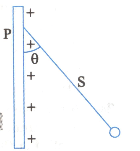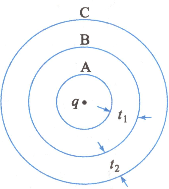MEDIUM
12th West Bengal Board
IMPORTANT
Earn 100
A charged ball hangs from a silk thread white makes an angle with a large charged conducting shut as shown in figure, Fig. 3.84. The surface charge density of the sheet is proportional to


(a)
(b)
(c)
(d)
50% studentsanswered this correctly

Important Questions on Gauss' Law and its Application
HARD
12th West Bengal Board
IMPORTANT
Consider three concentric shells of metal, and are having radii and respectively are shown in figure (Fig. 3.85). Their surface charge densities are and respectively. Calculate the electric potential on the surface of shell

MEDIUM
12th West Bengal Board
IMPORTANT
HARD
12th West Bengal Board
IMPORTANT
Figure (Fig. 3.86 ) show three spherical and equipotential surfaces and round a point charge The potential difference
If and be the distance between them. Then

MEDIUM
12th West Bengal Board
IMPORTANT
MEDIUM
12th West Bengal Board
IMPORTANT
MEDIUM
12th West Bengal Board
IMPORTANT
MEDIUM
12th West Bengal Board
IMPORTANT
MEDIUM
12th West Bengal Board
IMPORTANT
